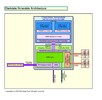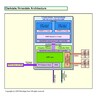Intel Core i7-640LM vs Intel Core i7-660UM
Intel Core i7-640LM
► remove from comparison
The Intel Core i7-640LM is a fast middle class low voltage dual core CPU for laptops and clocks (due to the Turbo Mode) from 2.16 to 2.93 GHz. Each core is based on the Nehalem (Westmere) micro-architecture. Hyperthreading enables the Dual Core CPU to handle 4 threads at once (for a better usage of the pipeline). Compared to the Core i7-620M, the 640LM is slower but more power efficient.
A feature of the new Core i7-640LM is the integrated graphics card (called Intel HD Graphics) and memory controller. Both are on a separate die that is still manufactured in 45nm whereas the CPU die is already manufactured in the new 32nm process.
Due to the integrated memory controller, the HyperThreading and Turbo Boost, the Core i5-640LM is faster than a similar clocked Core 2 Duo in all (us known) applications and benchmarks. The performance should be somewhere on the level of the Core i5-430M. Beware, that some designs may not feature the Turbo Boost or due to small cooling solutions, the TurboBoost may not trigger very often. Therefore, the performance could be worse.
The 32nm cpu cores of the Westmere generation can also process some new instructions to accelerate AES encryptions. Modern applications that support AES encoding can profit significantly using the new instructions (e.g. the Communications Suite test in the PCMark Vantage boosts up to 70% using AES in the faster Core i5-520M).
The integrated Intel Graphics Media Accelerator HD (GMA HD) graphics card is between 266-566 MHz (Turbo Boost) and therefore the base speed is clearly below the non low voltage versions. The performance should still be a lot faster than the old GMA 4500MHD.
The power consumption of 25 Watt TDP (max.) counts for the whole package and therefore it is clearly better than the 25 Watt TDP of the Core 2 Duo P-series (CPU alone).
Intel Core i7-660UM
► remove from comparison
The Intel Core i7-660UM is a Ultra Low Voltage dual-core processor for small and light laptops. It is clocked with 1.33 - 2.4 GHz (if Turbo Boost is enabled). The 660UM offers the highest TurboBoost of all 1.3 GHz clocked ULV processors (i3-380UM, i5-470UM, i5-560UM). Each core is based on the Nehalem (Westmere) micro-architecture. Hyperthreading enables the Dual Core CPU to handle 4 threads at once (for a better usage of the pipeline). Compared to the Core i7-620M and the 640LM, the 660UM is much slower (due to the lower clock rate) but more power efficient.
A feature of the new Core i7-660UM is the integrated graphics card (called Intel HD Graphics) and memory controller. Both are on a separate die that is still manufactured in 45nm whereas the CPU die is already manufactured in the new 32nm process.
Due to the integrated memory controller, the HyperThreading and Turbo Boost, the Core i7-660UM is faster than a similar clocked Core 2 Duo (1.33 GHz) in all (us known) applications and benchmarks. Still the Turbo Boost may not trigger very often (sometimes it is even not activated in the BIOS) and therefore the maximum of 2.4 GHz is not very important. All in all the I7-660UM should be faster than a Core 2 Duo SL9300 (1.6GHz).
The 32nm cpu cores of the Westmere generation can also process some new instructions to accelerate AES encryptions. Modern applications that support AES encoding can profit significantly using the new instructions (e.g. the Communications Suite test in the PCMark Vantage boosts up to 70% using AES in the faster Core i5-520M).
The integrated Intel Graphics Media Accelerator HD (GMA HD) graphics card is between 166-500 MHz (Turbo Boost) and therefore the base speed is clearly below the non low voltage versions. The performance should still be faster than the old GMA 4500MHD.
| Model | Intel Core i7-640LM | Intel Core i7-660UM | ||||||||||||||||||||||||||||||||||||||||||||||||||||||||||||||||||||||||
| Series | Intel Core i7 | Intel Core i7 | ||||||||||||||||||||||||||||||||||||||||||||||||||||||||||||||||||||||||
| Codename | Arrandale | Arrandale | ||||||||||||||||||||||||||||||||||||||||||||||||||||||||||||||||||||||||
| Series: Core i7 Arrandale |
|
| ||||||||||||||||||||||||||||||||||||||||||||||||||||||||||||||||||||||||
| Clock | 2130 - 2933 MHz | 1333 - 2400 MHz | ||||||||||||||||||||||||||||||||||||||||||||||||||||||||||||||||||||||||
| FSB | 2500 | 2500 | ||||||||||||||||||||||||||||||||||||||||||||||||||||||||||||||||||||||||
| L2 Cache | 512 KB | 512 KB | ||||||||||||||||||||||||||||||||||||||||||||||||||||||||||||||||||||||||
| L3 Cache | 4 MB | 4 MB | ||||||||||||||||||||||||||||||||||||||||||||||||||||||||||||||||||||||||
| Cores / Threads | 2 / 4 | 2 / 4 | ||||||||||||||||||||||||||||||||||||||||||||||||||||||||||||||||||||||||
| TDP | 25 Watt | 18 Watt | ||||||||||||||||||||||||||||||||||||||||||||||||||||||||||||||||||||||||
| Transistors | 382+177 Million | 382+177 Million | ||||||||||||||||||||||||||||||||||||||||||||||||||||||||||||||||||||||||
| Technology | 32 nm | 32 nm | ||||||||||||||||||||||||||||||||||||||||||||||||||||||||||||||||||||||||
| Die Size | 81+177 mm2 | 81+144 mm2 | ||||||||||||||||||||||||||||||||||||||||||||||||||||||||||||||||||||||||
| max. Temp. | 105 °C | 105 °C | ||||||||||||||||||||||||||||||||||||||||||||||||||||||||||||||||||||||||
| Socket | BGA1288 | BGA1288 | ||||||||||||||||||||||||||||||||||||||||||||||||||||||||||||||||||||||||
| Features | Turbo Boost (2.93 GHz max), Hyper Threading, Enhanced Speedstep, integrated GMA HD 266-566MHz | Turbo Boost (2.40 GHz max), Hyper Threading, Enhanced Speedstep, integrated GMA HD 166-500MHz | ||||||||||||||||||||||||||||||||||||||||||||||||||||||||||||||||||||||||
| Architecture | x86 | x86 | ||||||||||||||||||||||||||||||||||||||||||||||||||||||||||||||||||||||||
| $332 U.S. | ||||||||||||||||||||||||||||||||||||||||||||||||||||||||||||||||||||||||||
| Announced | ||||||||||||||||||||||||||||||||||||||||||||||||||||||||||||||||||||||||||
| Manufacturer | ark.intel.com |


 Deutsch
Deutsch English
English Español
Español Français
Français Italiano
Italiano Nederlands
Nederlands Polski
Polski Português
Português Русский
Русский Türkçe
Türkçe Svenska
Svenska Chinese
Chinese Magyar
Magyar
